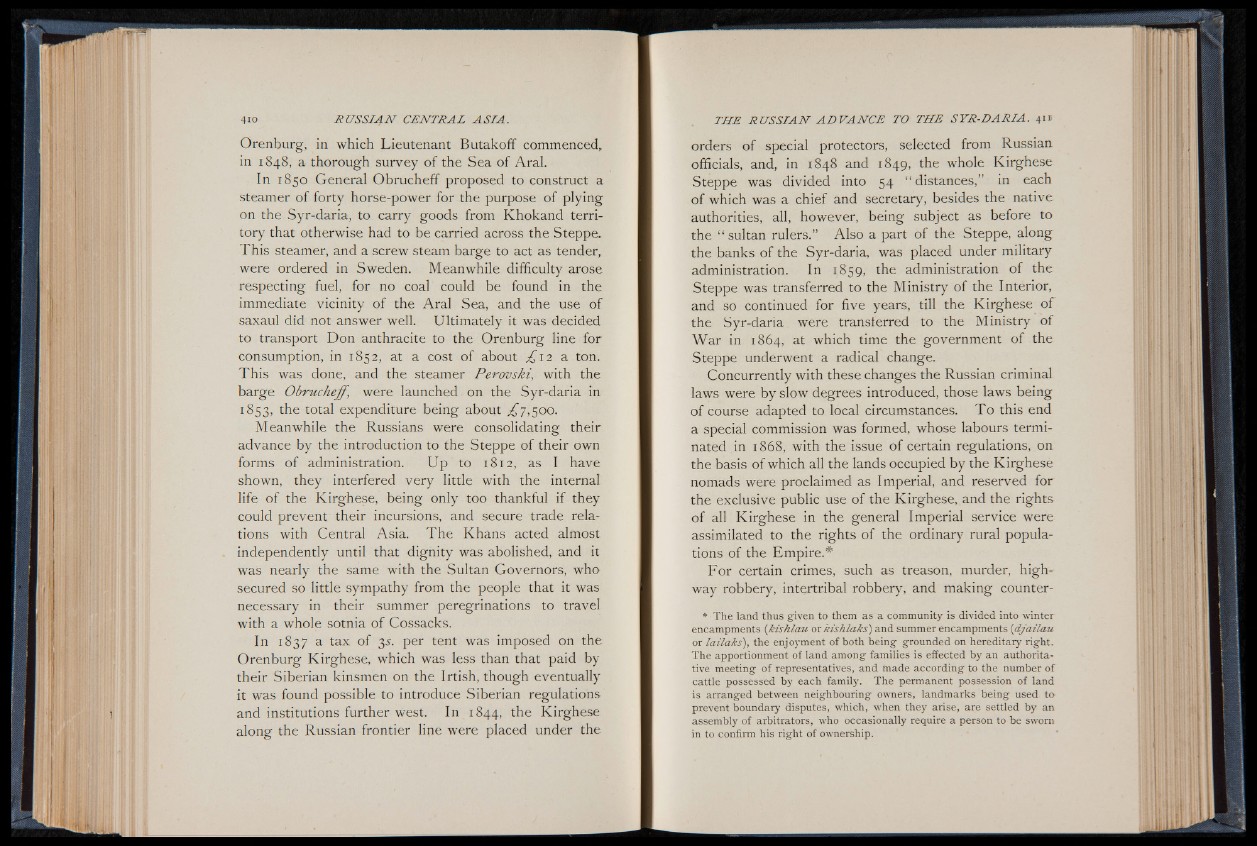
Orenburg, in which Lieutenant Butakoff commenced,
in 1848, a thorough survey of the Sea of Aral.
In 1850 General Obrucheff proposed to construct a
steamer of forty horse-power for the purpose of plying
on the Syr-daria, to carry goods from Khokand territory
that otherwise had to be carried across the Steppe.
This steamer, and a screw steam barge to act as tender,
were ordered in Sweden. Meanwhile difficulty arose
respecting fuel, for no coal could be found in the
immediate vicinity of the Aral Sea, and the use of
saxaul did not answer well. Ultimately it was decided
to transport Don anthracite to the Orenburg line for
consumption, in 1852, at a cost of about ¿ 1 2 a ton.
This was done, and the steamer Perovski, with the
barge Obrucheff, were launched on the Syr-daria in
1853, ^ e total expenditure being about .£7,500.
Meanwhile the Russians were consolidating their
advance by the introduction to the Steppe of their own
forms of administration. Up to 1812, as I have
shown, they interfered very little with the internal
life of the Kirghese, being only too thankful if they
could prevent their incursions, and secure trade relations
with Central Asia. The Khans acted almost
independently until that dignity was abolished, and it
was nearly the same with the Sultan Governors, who
secured so little sympathy from the people that it was
necessary in their summer peregrinations to travel
with a whole sotnia of Cossacks.
In 1837 a tax of 3^. per tent was imposed on the
Orenburg Kirghese, which was less than that paid by
their Siberian kinsmen on the Irtish, though eventually
it was found possible to introduce Siberian regulations
and institutions further west. In 1844, the Kirghese
along the Russian frontier line were placed under the
orders of special protectors, selected from Russian
officials, and, in 1848 and 1849, the whole Kirghese
Steppe was divided into 54 “ distances,” in each
of which was a chief and secretary, besides the native
authorities, all, however, being subject as before to
the “ sultan rulers.” Also a part of the Steppe, along
the banks of the Syr-daria, was placed under military
administration. In 1859, the administration of the
Steppe was transferred to the Ministry of the Interior,
and so continued for five years, till the Kirghese of
the Syr-daria were transferred to the Ministry of
War in 1864, at which time the government of the
Steppe underwent a radical change.
Concurrently with these changes the Russian criminal
laws were by slow degrees introduced, those laws being
of course adapted to local circumstances. T o this end
a special commission was formed, whose labours terminated
in 1868, with the issue of certain regulations, on
the basis of which all the lands occupied by the Kirghese
nomads were proclaimed as Imperial, and reserved for
the exclusive public use of the Kirghese, and the rights
of all Kirghese in the general Imperial service were
assimilated to the rights of the ordinary rural populations
of the Empire.*
For certain crimes, such as treason, murder, highway
robbery, intertribal robbery, and making counter-
* The land thus given to them as a community is divided into winter
encampments (kishlau or kishlaks) and summer encampments (djailau
or la.ila.ks), the enjoj'ment of both being grounded on hereditary right.
The apportionment of land among families is effected by an authoritative
meeting of representatives, and made according to the number of
cattle possessed by each family. The permanent possession of land
is arranged between neighbouring owners, landmarks being used to
prevent boundary disputes, which, when they arise, are settled by an
assembly of arbitrators, who occasionally require a person to be sworn
in to confirm his right of ownership.